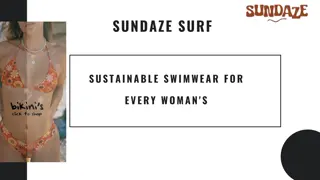The Ultimate Guide to Surf Wetsuits
Wetsuits play a vital role in enhancing your surfing experience. Factors like size, thickness, seams, and entry systems are crucial to consider. Choosing the right wetsuit based on these factors can improve comfort, flexibility, and warmth while surfing in varying water conditions.
Download Presentation

Please find below an Image/Link to download the presentation.
The content on the website is provided AS IS for your information and personal use only. It may not be sold, licensed, or shared on other websites without obtaining consent from the author.If you encounter any issues during the download, it is possible that the publisher has removed the file from their server.
You are allowed to download the files provided on this website for personal or commercial use, subject to the condition that they are used lawfully. All files are the property of their respective owners.
The content on the website is provided AS IS for your information and personal use only. It may not be sold, licensed, or shared on other websites without obtaining consent from the author.
E N D
Presentation Transcript
The Ultimate Guide To Surf Wetsuits
Wetsuit Size The first and maybe most important factor you ll need to consider for your suit is size. Wetsuit sizing will vary from brand to brand so it s important you reference the size chart for the relevant brand you re looking at, or better yet, head in store and try them on. Ideally, you want your wetsuit to fit like a second skin without restricting your range of motion. Having a suit that s a little too big might make donning & doffing easier, but it s going to hinder the suits function and ultimately your experience in the water. Similarly, squeezing into a wettie that s too small can reduce its water sealing and increases the likelihood of a tear.
Wetsuit Thickness The thickness of your suit will depend on where you re surfing and what time of the year it is. But one of the most important factors of wetsuit thickness is preference, which is something that can vary a lot from person to person. This takes time in the water to figure out, but generally for temperate waters usually a 3/2mm Steamer will suffice for during winter. Personally, I spend most of my time surfing on the Gold Coast and a 2mm short sleeve steamer is plenty warm enough. Further North, most people will opt for a 2mm Spring Suit or even just a Neoprene Jacket for through the winter. Once you re getting into those colder south coast waters, depending on how thick your skin is, jumping into a 4/3mm or even a 5/4 might be more appropriate.
Wetsuit Seams Another important factor of your wetsuit is the stitching. Stitching plays a huge role in the durability and sealing capabilities of the wetsuit and can drastically change how flexible a suit feels and performs. There s a fair bit of variability when it comes to seam styles and it can be a bit to wrap your head around, but we ll give you a rundown on the basics.
Wetsuit Entry Systems The entry system of your wetsuit plays a large role in its overall function. The type of zip used will influence the suits overall flexibility, seal and ease of entry. Today, surfing suits are tending towards chest enclosures, as they maximise paddle flexibility, back flexibility and limit cold water flushing. Unfortunately, all zips are inherently permeable to water. However, backing the zipper with neoprene forces the water to exit the suit. However, the best kind of zip is actually no zip at all. Zipperless suits are the stretchiest suits out there, as the flexibility isn t compromised by the zip. You get all the benefits of a chest zip without limiting stretch in both paddling and general movement.For entry-level suits you ll find that most will feature a back-zip. Back-zips are easiest to get on and off but aren t as warm as a chest zip and don t offer the same ease of movement
Wetsuit Styles There are many styles from the steamer to the long jane and aside from fit, the most important thing to consider is more rubber = more warmth = less stretch. Also, it s worth noting that you can always cool yourself down inside a wetsuit by opening the neck and flushing cold water into the chest area. Here s a rundown on the different wetsuit styles:
Wetsuit Brands There are many brands that make surf specific wetsuits. We stock quality suits for every price range, so check out our different suits on our surfing page to see what s best for you.
Thank You Website: https://surfd.com/category/product-reviews/surf_wetsuits/




























